-
New launch and recovery system for the Scan Eagle UAV
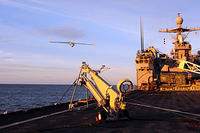
A shipboard-capable system designed to support both the launch and recovery of the Scan Eagle UAV successfully completed final demonstration flight testing on 27 September at a testing range in eastern Oregon
-
-
Fueling UAVs in flight
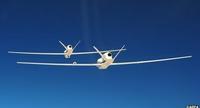
DARPA completes close-proximity flight tests of two modified RQ-4 Global Hawk unmanned aerial vehicles, demonstrating technology enabling autonomous aerial refueling
-
-
Scenario-based gaming exercise to improve intelligence analysis
Raytheon has created a scenario-based gaming exercise to study in depth the intelligence analyst’s tradecraft; the company says the goal is ultimately to help analysts produce the best intelligence products and streamline workflows
-
-
Hezbollah drone shot down over Israel
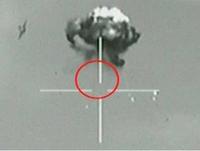
The Israel Air Force (IAF) planes shot down a UAV over the north Negev; the UAV entered Israeli air space from the west, but Israeli intelligence says the drone was launched by Hezbollah in Lebanon, then made its way south over the Mediterranean, then turned east when it reached the water off the Gaza Strip
-
-
U.K. military’s drone spending keep rising
In an effort to boost its military, the United Kingdom, over the past five years, has spent more than two billion euros buying and developing unmanned drones; the U.K. has no intention of slowing down, as it is committed to spending another two billion euros on new unmanned aircraft
-
-
The negative effects of increasing computerized surveillance

To understand the effects of continuous computerized surveillance on individuals, Finnish researchers equipped ten Finnish households with video cameras, microphones, and logging software for personal computers, wireless networks, smartphones, TVs, and DVDs – then followed what happened
-
-
Electronic surveillance by U.S. law enforcement agencies has increased dramatically

According to data obtained by the American Civil Liberties Union (ACLU), U.S. law enforcement’s surveillance of e-mails and other Internet communication has skyrocketed in the last two years; some forms of surveillance have increased 361 percent
-
-
Senate panel’s report harshly criticizes role, utility of DHS fusion centers
A 2-year bipartisan investigation by the U. S. Senate Permanent Subcommittee on Investigations has found that DHS efforts to engage state and local intelligence “fusion centers” has not yielded significant useful information to support federal counterterrorism intelligence efforts; the report says that senior DHS officials were aware of the problems hampering effective counterterrorism work with the fusion centers, but did not always inform Congress of the issues, nor ensure the problems were fixed in a timely manner; DHS estimates that it has spent somewhere between $289 million and $1.4 billion in public funds to support state and local fusion centers since 2003 (the report says that these are broad estimates which differ by over $1 billion); the Senate investigation raises questions about the value this amount of funding and the contribution the fusion centers make to the U.S. counterterrorism efforts; not everyone agrees with the report; Rep. Peter King (R-NY), chairman of the House Committee on Homeland Security, said: “I agree with Chairman Joe Lieberman and Ranking Member Susan Collins [of the Senate Committee on Homeland Security] that the subcommittee report issued this week paints with too broad a brush an incomplete picture that fails to recognize many of the important contributions that fusion centers have made in securing our Homeland”
-
-
Future of interrogation methods of terrorists may depend on election
On the campaign trail, Barack Obama and Mitt Romney have not said much about their approach to interrogating terrorists; but as the manner in which U.S. government agencies approach such interrogations, and the practices agents employ, may well depend on the outcome of next month’s election
-
-
DHS focus on suspicious activity at critical infrastructure facilities
Federal, state, and local law enforcement let people know that if theytake pictures or notes around monuments and critical infrastructure facilities, theycould be subject to an interrogation or an arrest; in addition to the See Something, Say Something awareness campaign, DHS also has broader initiatives such as the Buffer Zone Protection Program, which teach local police and security how to spot potential terrorist activities
-
-
Technology soon to make drones deadlier, more autonomous
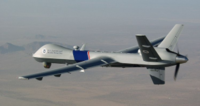
Unmanned aerial vehicles (UAVs) have become America’s main weapon in the campaign against terrorists — at the forefront are the Predator and the Reaper — and technological changes would soon make them even deadlier; in the next decade drones will be faster and carry more weapons than today’s versions; they will also have better sensors and more sophisticated computers, allowing them to plan and execute attacks with little human participation
-
-
Critics: U.S. not doing enough to combat domestic terrorism
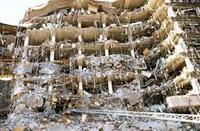
The effectiveness of the U.S. campaign against al Qaeda and its affiliates may have reduced the threat of foreign terrorists launching attacks on targets in the United States, but the threat of terrorism the United States is facing has not been reduced owing to the rise in domestic terrorism
-
-
LAPD wants to know why you are taking these photos
If you live in Los Angeles and decide to take some pictures of a few monuments or public places to send to friends and family or for your own private collection, the Los Angeles Police Department (LAPD) may see you as a potential threat to public safety
-
-
German police wants to develop its own computer surveillance software
The Federal Police Office of Germany (also known as the BKA) is looking to hire software engineers who can develop computer surveillance technology for use by law enforcement and intelligence agencies in criminal investigations
-
-
Threat-recognition technology incorporates mind, machine

For soldiers operating in the field, the ability to detect threats from standoff distances can be life-saving; when advanced radar and drone coverage is not available, soldiers typically rely on their own vision to scan their surroundings; DARPA links human brainwaves, improved sensors, and cognitive algorithms to improve target detection
-
- All
- Regional
- Water
- Biometrics
- Borders/Immig
- Business
- Cybersecurity
- Detection
- Disasters
- Government
- Infrastructure
- International
- Public health
- Public Safety
- Communication interoperabillity
- Emergency services
- Emergency medical services
- Fire
- First response
- IEDs
- Law Enforcement
- Law Enforcement Technology
- Military technology
- Nonlethal weapons
- Nuclear weapons
- Personal protection equipment
- Police
- Notification /alert systems
- Situational awareness
- Weapons systems
- Sci-Tech
- Sector Reports
- Surveillance
- Transportation
Advertising & Marketing: advertise@newswirepubs.com
Editorial: editor@newswirepubs.com
General: info@newswirepubs.com
2010-2011 © News Wire Publications, LLC News Wire Publications, LLC
220 Old Country Road | Suite 200 | Mineola | New York | 11501
Permissions and Policies
Editorial: editor@newswirepubs.com
General: info@newswirepubs.com
2010-2011 © News Wire Publications, LLC News Wire Publications, LLC
220 Old Country Road | Suite 200 | Mineola | New York | 11501
Permissions and Policies
